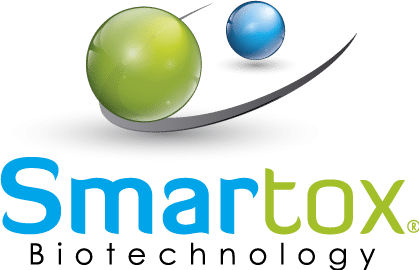- ProTx-III: selective Nav1.7 blocker
- ProTx-I: potent Nav channels blocker
- OD1 peptide: Nav1.7 activator
- Huwentoxin IV: potent Nav channels blocker
- Biotin-ProTx-II: biotinylated ProTx-II
- Cy5-ProTx-II: fluorescent ProTx-II
8xHis-ProTx-II
440 € – 1320 €
8xHis-ProTx-II, Nav1.7 selective blocker
ProTx-II (ProTx-2, Protoxin II) is a toxin that was originally isolated from Thrixopelma pruriens (Peruvian green velvet tarantula). ProTx-II inhibits both tetrodotoxin-sensitive and tetrodotoxin-resistant voltage-gated sodium channels. ProTx-II inhibits activation by shifting the voltage-dependence of channel activation to more positive potentials. ProTx-II blocks Nav1.7 with an IC50 value of around 300 pM, Nav1.2, Nav1.5 and Nav1.6 with IC50 values of 41 nM, 79 nM and 26 nM respectively. It also acts on Cav3.1/CACNA1G and interacts more weakly with the related T-Type channel Cav3.2/CACNA1H but potently inhibits the L-type calcium channel Cav1.2/CACNA1C. ProTx-II blocks action potential propagation in nociceptors. 8xHis-ProTx-II is a polyhistidine tagged version of ProTx-II.
Spider-venom peptides that target voltage-gated sodium channels: pharmacological tools and potential therapeutic leads
Voltage-gated sodium (Na(V)) channels play a central role in the propagation of action potentials in excitable cells in both humans and insects. Many venomous animals have therefore evolved toxins that modulate the activity of Na(V) channels in order to subdue their prey and deter predators. Spider venoms in particular are rich in Na(V) channel modulators, with one-third of all known ion channel toxins from spider venoms acting on Na(V) channels. Here we review the landscape of spider-venom peptides that have so far been described to target vertebrate or invertebrate Na(V) channels. These peptides fall into 12 distinct families based on their primary structure and cysteine scaffold. Some of these peptides have become useful pharmacological tools, while others have potential as therapeutic leads because they target specific Na(V) channel subtypes that are considered to be important analgesic targets. Spider venoms are conservatively predicted to contain more than 10 million bioactive peptides and so far only 0.01% of this diversity been characterised. Thus, it is likely that future research will reveal additional structural classes of spider-venom peptides that target Na(V) channels.
Klint JK., et al. (2012) Spider-venom peptides that target voltage-gated sodium channels: pharmacological tools and potential therapeutic leads. Toxicon. PMID: 22543187
Evidence for multiple effects of ProTxII on activation gating in Na(V)1.5
The peptide toxin ProTxII, recently isolated from the venom of the tarantula spider Thrixopelma pruriens, modifies gating in voltage-gated Na+ and Ca2+ channels. ProTxII is distinct from other known Na+ channel gating modifier toxins in that it affects activation, but not inactivation. It shifts activation gating positively and decreases current magnitude such that the dose-dependence of toxin action measured at a single potential reflects both effects. To test the extent to which these effects were independent, we tracked several different measures of current amplitude, voltage-dependent activation, and current kinetics in Na(V)1.5 in a range of toxin concentrations. Changes in voltage dependence and a decrease in G(max) appeared at relatively low concentrations (40-100 nM) while a positive shift in the voltage range of activation was apparent at higher toxin concentrations (> or =500 nM). Because ProTxII carries a net +4 charge we tested whether electrostatic interactions contributed to toxin action. We examined the effects of ProTxII in the presence of high extracellular Ba2+, known to screen and/or bind to surface charge. Some, but not all aspects of ProTxII modification were sensitive to the presence of Ba2+ indicating the contribution of an electrostatic, surface charge-like mechanism and supporting the idea of a multi-faceted toxin-channel interaction.
Edgerton G. B., et al. (2008) Evidence for multiple effects of ProTxII on activation gating in Na(V)1.5, Toxicon. PMID: 18657562
ProTx-II, a selective inhibitor of Nav1.7 sodium channels, blocks action potential propagation in nociceptors
Voltage-gated sodium (Na(V)1) channels play a critical role in modulating the excitability of sensory neurons, and human genetic evidence points to Na(V)1.7 as an essential contributor to pain signaling. Human loss-of-function mutations in SCN9A, the gene encoding Na(V)1.7, cause channelopathy-associated indifference to pain (CIP), whereas gain-of-function mutations are associated with two inherited painful neuropathies. Although the human genetic data make Na(V)1.7 an attractive target for the development of analgesics, pharmacological proof-of-concept in experimental pain models requires Na(V)1.7-selective channel blockers. Here, we show that the tarantula venom peptide ProTx-II selectively interacts with Na(V)1.7 channels, inhibiting Na(V)1.7 with an IC(50) value of 0.3 nM, compared with IC(50) values of 30 to 150 nM for other heterologously expressed Na(V)1 subtypes. This subtype selectivity was abolished by a point mutation in DIIS3. It is interesting that application of ProTx-II to desheathed cutaneous nerves completely blocked the C-fiber compound action potential at concentrations that had little effect on Abeta-fiber conduction. ProTx-II application had little effect on action potential propagation of the intact nerve, which may explain why ProTx-II was not efficacious in rodent models of acute and inflammatory pain. Mono-iodo-ProTx-II ((125)I-ProTx-II) binds with high affinity (K(d) = 0.3 nM) to recombinant hNa(V)1.7 channels. Binding of (125)I-ProTx-II is insensitive to the presence of other well characterized Na(V)1 channel modulators, suggesting that ProTx-II binds to a novel site, which may be more conducive to conferring subtype selectivity than the site occupied by traditional local anesthetics and anticonvulsants. Thus, the (125)I-ProTx-II binding assay, described here, offers a new tool in the search for novel Na(V)1.7-selective blockers.
William A., et al. (2007) ProTx-II, a selective inhibitor of Nav1.7 sodium channels, blocks action potential propagation in nociceptors. Mol. Pharm. PMID: 18728100
ProTx-I and ProTx-II: gating modifiers of voltage-gated sodium channels
The tarantula venom peptides ProTx-I and ProTx-II inhibit voltage-gated sodium channels by shifting their voltage dependence of activation to a more positive potential, thus acting by a mechanism similar to that of potassium channel gating modifiers such as hanatoxin and VSTX1. ProTx-I and ProTx-II inhibit all sodium channel (Nav1) subtypes tested with similar potency and represent the first potent peptidyl inhibitors of TTX-resistant sodium channels. Like gating modifiers of potassium channels, ProTx-I and ProTx-II conform to the inhibitory cystine knot motif, and ProTx-II was demonstrated to bind to sodium channels in the closed state. Both toxins have been synthesized chemically, and ProTx-II, produced by recombinant means, has been used to map the interaction surface of the peptide with the Nav1.5 channel. In comparison, beta-scorpion toxins activate sodium channels by shifting the voltage dependence of activation to more negative potentials, and together these peptides represent valuable tools for exploring the gating mechanism of sodium channels.
Priest B. T., et al. (2007) ProTx-I and ProTx-II: gating modifiers of voltage-gated sodium channels, Toxicon. PMID: 17087985
Differential phospholipid binding by site 3 and site 4 toxins. Implications for structural variability between voltage-sensitive sodium channel domains
It has been shown recently that polypeptide toxins that modulate the gating properties of voltage-sensitive cation channels are able to bind to phospholipid membranes, leading to the suggestion that these toxins are able to access a channel-binding site that remains membrane-restricted (Lee, S.-Y., and MacKinnon, R. (2004) Nature 430, 232-235). We therefore examined the ability of anthopleurin B (ApB), a sea anemone toxin that selectively modifies inactivation kinetics of Na(V)1.x channels, and ProTx-II, a spider toxin that modifies activation kinetics of the same channels, to bind to liposomes. Whereas ProTx-II can be quantitatively depleted from solution upon incubation with phosphatidylcholine/phosphatidylserine liposomes, ApB displays no discernible phospholipid binding activity. We therefore examined the activities of structurally unrelated site 3 and site 4 toxins derived from Leiurus and Centruroides venoms, respectively, in the same assay. Like ApB, the site 3 toxin LqqV shows no lipid binding activity, whereas the site 4 toxin Centruroides toxin II, like ProTx-II, is completely bound. We conclude that toxins that modify inactivation kinetics via binding to Na(V)1.x site 3 lack the ability to bind phospholipids, whereas site 4 toxins, which modify activation, have this activity. This inherent difference suggests that the conformation of domain II more closely resembles that of the K(V)AP channel than does the conformation of domain IV.
Smith J. J., et al. (2005) Differential phospholipid binding by site 3 and site 4 toxins. Implications for structural variability between voltage-sensitive sodium channel domains, J Biol Chem. PMID: 15632158
Two tarantula peptides inhibit activation of multiple sodium channels
Two peptides, ProTx-I and ProTx-II, from the venom of the tarantula Thrixopelma pruriens, have been isolated and characterized. These peptides were purified on the basis of their ability to reversibly inhibit the tetrodotoxin-resistant Na channel, Na(V) 1.8, and are shown to belong to the inhibitory cystine knot (ICK) family of peptide toxins interacting with voltage-gated ion channels. The family has several hallmarks: cystine bridge connectivity, mechanism of channel inhibition, and promiscuity across channels within and across channel families. The cystine bridge connectivity of ProTx-II is very similar to that of other members of this family, i.e., C(2) to C(16), C(9) to C(21), and C(15) to C(25). These peptides are the first high-affinity ligands for tetrodotoxin-resistant peripheral nerve Na(V) channels, but also inhibit other Na(V) channels (IC(50)’s < 100 nM). ProTx-I and ProTx-II shift the voltage dependence of activation of Na(V) 1.5 to more positive voltages, similar to other gating-modifier ICK family members. ProTx-I also shifts the voltage dependence of activation of Ca(V) 3.1 (alpha(1G), T-type, IC(50) = 50 nM) without affecting the voltage dependence of inactivation. To enable further structural and functional studies, synthetic ProTx-II was made; it adopts the same structure and has the same functional properties as the native peptide. Synthetic ProTx-I was also made and exhibits the same potency as the native peptide. Synthetic ProTx-I, but not ProTx-II, also inhibits K(V) 2.1 channels with 10-fold less potency than its potency on Na(V) channels. These peptides represent novel tools for exploring the gating mechanisms of several Na(V) and Ca(V) channels.
Middleton R. E., et al. (2002) Two tarantula peptides inhibit activation of multiple sodium channels, Biochemistry. PMID: 12475222

